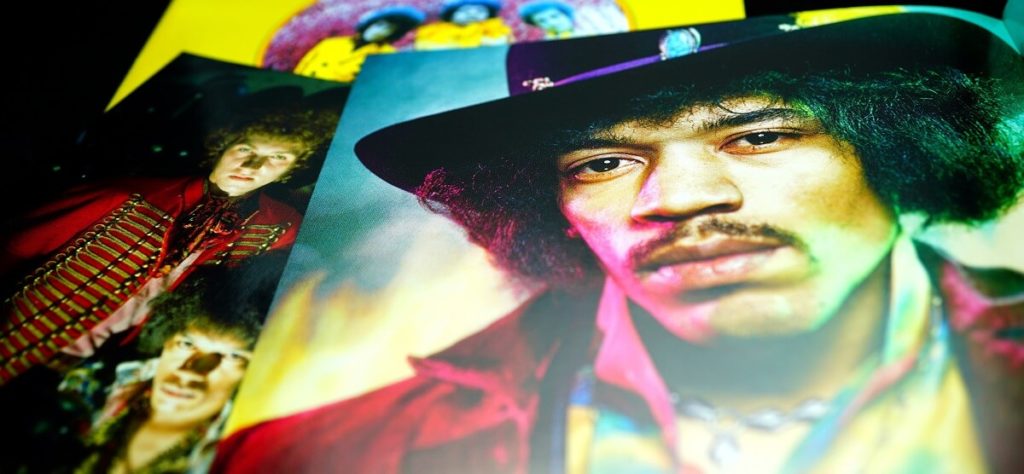
Jimi Hendrix is one of the most unique musicians in American history. His ferocious and fuzz-driven tone innovated the electric guitar and rock music approach.
Born James Allen Hendrix, “Jimi” grew up in Seattle. His parents changed his middle name to Marshall in a twist of ironic fate (Jimi Hendrix famously played through Marshall amplifiers later in his career).
He took to music quickly, and his first instrument was a broom that he would pretend was a guitar. His father gave him a one-stringed ukulele instead of the broom, and he quickly upgraded to an acoustic guitar.
He joined a few bands and purchased an electric guitar before enlisting in the Army in 1961. After a very brief military career, Jimi was discharged into civilian life.
He pursued work as a session guitar player; however, being a unique character, his session days did not last long.
Part of his individual identity was the fact that he actually played his guitar upside down.
Have you ever wondered why Jimi Hendrix played his guitar upside down?
Jimi Hendrix played his guitar upside down because he was left-handed and couldn’t find a left-handed guitar. He refused to learn with his right hand and instead innovated by using a regular right-handed guitar and flipping it over. He also made several modifications to the hardware and changed the strings to make it playable. Although he was not the first musician to adopt this technique, Hendrix popularized it and became known for his distinctive sound.
To understand why Jimi played his guitar upside down helps to understand the context. First, guitars are built for either left-handed or right-handed players and are not meant to be both.
Left-handed guitars are notoriously hard to find. As a result, many lefties are encouraged to learn with their non-dominant hand for convenience. Despite his father’s suggestion, Hendrix did not want to learn with his right hand, so he became an innovator.
He took a regular right-handed guitar and turned it upside down. He also had to change the strings and alter the hardware so that it would play properly. While he may not have been the first player to make this adjustment, he was undoubtedly the most popular.
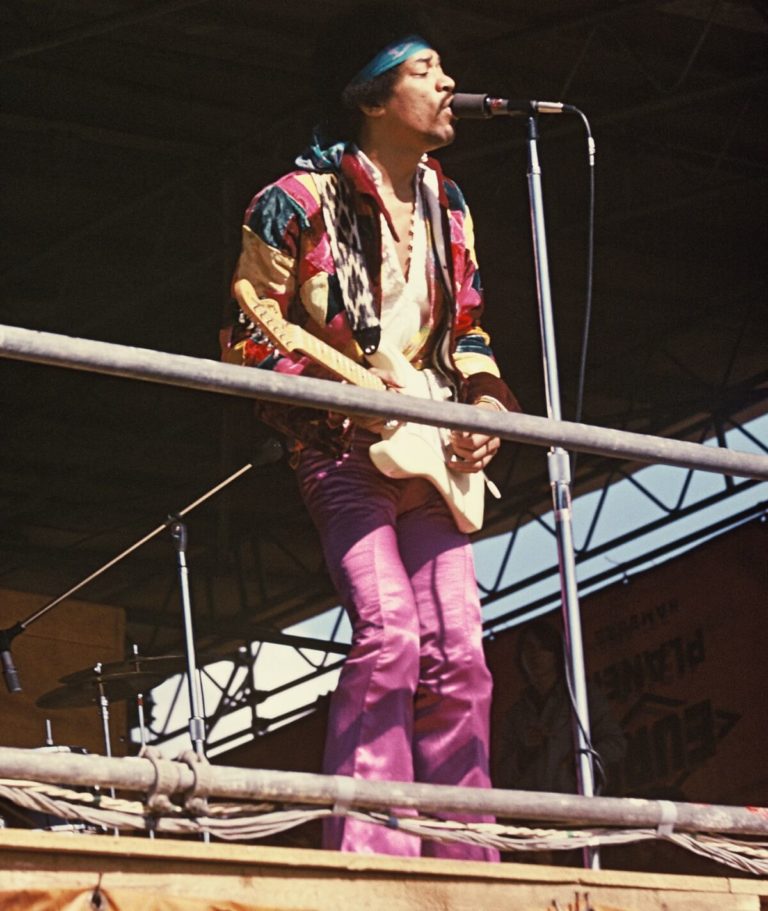
Something that many people do not know is that Jimi Hendrix was actually ambidextrous. He performed most of his daily tasks with his right hand, but when playing the guitar, he was more natural with his left. This enhanced his identity and set him apart from others.
He accepted a contract in 1966 that took him to London, where he formed his own band, The Jimi Hendrix Experience. This was a huge turning point in his career. With his upside-down guitar and two bandmates, he quickly became the talk of the town. People had never seen someone so entertaining and exciting.
Word of his performances spread throughout Europe and the United States, and his music gained traction on the charts. However, his secret may be based on his unusual approach to the instrument.
Although he couldn’t formally read music, Jimi developed his musical style by expanding on blues players like Muddy Waters, Howlin’ Wolf, B.B. King, and Robert Johnson. He took their grassroots approach to the guitar and electrified it through a large stack of amplifiers.
He used distortion, speed, and sheer volume to enhance the soulful style and make it exciting for a new generation.
While his career was short-lived, he is known as an everlasting founder of psychedelic rock music. He always credited his early years as most influential as the stages grew. He tried to be a session player while playing in studios for other artists but was too experimental.
So he cut his teeth in Nashville, TN as a young musician. His band during this time, The King Kasuals, played in Printers Alley and Jefferson Street bars while participating in racial protests in the South. One of the actual stages that Jimi Hendrix played on, as well as his modified Fender Stratocaster, outfits, and Mitch Mitchell’s drum kit (of the Jimi Hendrix Experience), can be seen at the Musicians Hall of Fame and Museum in Nashville.
The museum is an homage to musicians throughout history that created the soundtracks to our lives. The Jimi Hendrix exhibit is inspiring with its psychedelic artwork, genuine gear, and informative stories. Purple haze emanates from the ceiling as guests learn more about the roots of the legendary guitar player and his time in Nashville.
It is a favorite of visitors to the museum and one of the more immersive exhibits on display.
To see the exhibit in person, please visit the Musicians Hall of Fame and Museum, open Monday through Saturday, 10am-5pm. While visiting, you can also see exhibits highlighting artists that influenced Hendrix, like B.B. King. King’s exhibit displays two of his personal Lucille guitars, road cases, and outfits. The museum is a gem in Music City, located conveniently within the downtown area.
While Jimi Hendrix may no longer light up stages with his unique, upside-down guitar and incredible style, his legacy is today in museums and radios worldwide. Because of Hendrix, many kids and adults picked up the guitar and pursued their musical expression.
For me personally, Jimi Hendrix’s music changed my life and made me want to learn guitar. From the first time I heard his heavy, explosive playing, I knew I wanted to try to play along. But he has also inspired me to cling to what makes me unique.
Although I do not play my guitar upside-down, I find unconventional ways to express myself, which may set me apart as an artist. But, like Hendrix, we all have habits that we can creatively innovate in our own lives.
Jimi Hendrix FAQs
Did Jimi Hendrix die at 27?
Yes, Jimi Hendrix died at the age of 27. He passed away on September 18, 1970, in London, England. Hendrix died from asphyxia while intoxicated with barbiturates, which were found in his system during the autopsy. The circumstances surrounding his death remain somewhat controversial, and there have been various theories proposed over the years, but the official cause of death was ruled as accidental.
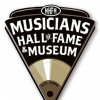
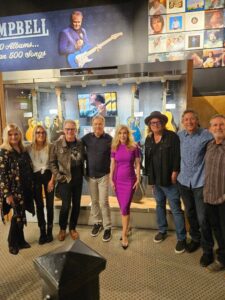

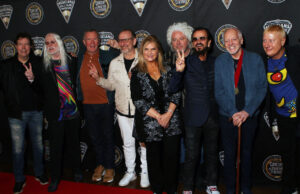

8 responses
In 1968 i was able to find a left hand electric guitar in NYC. It was not very difficult so i dont know why a guitar star could not have found a lefthand fender.
At the time Hendrix was learning to play a guitar they where probably very rare if not at all. By the time guitar builders started making a few lefty ones. Hendrix was already comfortable with what he was using. In the 80’s, it was hard for me to get a half quality guitar at a reasonable price. I definitely didn’t have the options there are today! I’m 52 now and started to get back into learning to play guitar. Finally got my first left handed guitar from a pawn shop.
Totally agree. My theory is his right hand technique. It is the same as the Gypsy/Django Rheinhardt technique. Even when playing lead, you still play exactly the same as when strumming. With a relaxed bent wrist shaking out a match type action.
This means that the tone, volume (and on the strat, the pickup switch) really gets in the way and they keep getting knocked about and the pickup switch changed.
With amplification, a ‘modern’ right hand technique has emerged, with flat wrist and the hand usually resting on the bridge. The old one gives more volume and energy to the strings, unecessary whith amplification.
Next time I’m in Nashville I’ll try to stop by.
I Hendrix in the summer of 1070 in a Pecan grove S of Macon GA on the 4 of July at night.What a SHOW!
I love Jimi Hendrix as a musician, he was totally creative, imaginative and innovative always searching for new ways to express sound. The same can be said for Miles Davis, John Coltrane, Terry Kath, Duane Allman & Prince. Beyond Hendrix using a right handed guitar, rearranging the strings and hardware. There’s more to this.. if a right handed person used a left handed guitar the volume, tone controls and whammy bar are no longer at the bottom..they are now on the top..multitasking! A person can adjust the tone and volume controls with the edge of their hand or the whammy bar while playing.. some of Hendrix music…the star bangle banner you can see him doing this. I personally love music..all music especially jazz, blues, Latin, classical, folk, rock, funk..music has a healing effect and universal language..same notes various ways of express…music is the message.. music in the air the feelings everywhere 🎼🎶🎶🎶🎶
Jimi played a right hand Stratocaster, strung left handed. Albert King played a Flying V strung right handed, but flipped it over to left hand strumming pulling down on his bends with his right hand. Jimi usually pushed up on two, two and a half step bends. Watch both.
Albert King very seldom, and I mean VERY SELDOM,played chords & RYTHM if he played them at all. His playing was mostly Licks & bends which is the reason he & the Great BB King mostly traveled with a Rythm section. BB himself admitted this .Jimi was Incredible in that he could play lead & Rythm Guitar at the same time while singing lead vocals. Un heard of @ the time.